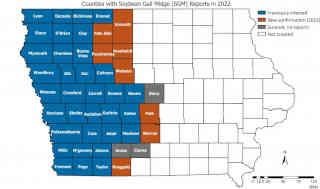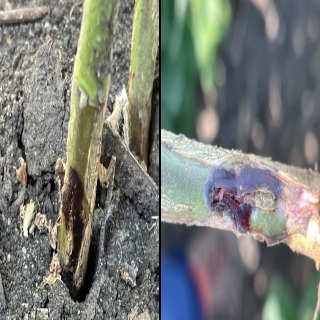By Ashley Dean and Dr. Erin Hodgson
Several labs in the Midwest have been monitoring the distribution of soybean gall midge in Iowa since 2018. Last year, we sampled many counties in western Iowa but only confirmed three new counties. This year, we focused on the counties just east of the distribution in 2021 and were able to confirm eight new counties in Iowa that had soybean gall midge: Humboldt, Kossuth, Palo Alto, Pocahontas, Polk, Ringgold, Warren, and Webster (Figure 1). Iowa now has 42 counties confirmed with soybean gall midge, nearly half of the state. To see the distribution in other states, visit our regional website (155 total counties in five states).

Figure 1. Counties with soybean gall midge in Iowa (as of 22 August 2022). Orange highlighted counties were confirmed in 2022. Gray counties were scouted but not confirmed.
In the newly confirmed counties, we stopped in random soybean fields on the western half of each county. We prioritized soybean fields that shared a border with a cornfield (see explanation below). Once we found an ideal field, we checked plants at the edge (next to corn) for dead/dying plants, wilting, or black lesions at the base of the stem. If lesions were found, we pulled the plants and opened the lesions to confirm that soybean gall midge larvae were inside (Photo 1).

Photo 1. Black lesions form at the base of the plant near the soil line (left) as a result of larval feeding injury. When the lesions are opened, larvae can be found inside. Here, you can see the orange, third instar, through the lesion (right).
The fields we confirmed larvae in this year had low infestation levels – we could only find a few plants with black lesions and there were less than five larvae inside. Make sure to check field edges for dead plants, wilting, and black lesions, then break the stem open to confirm that soybean gall midge larvae are inside. Infestations in new counties may be difficult to spot because of this low incidence or be confused with fungal pathogens.
There are no proven management tactics available for soybean gall midge at this time. Insecticides are likely ineffective because the larvae feed inside of the stem and are difficult to reach. We recommend monitoring for larvae during July and August, especially in soybean fields that have a border with a field where soybean was planted the previous year.
For more information on soybean gall midge, read this ICM encyclopedia article. If you are interested in real-time updates on soybean gall midge activity and distribution in 2023, join the Soybean Gall Midge Alert Network or the Iowa Pest Alert Network.
First detection scouting tips:
Midges overwinter in soybean fields and begin adult emergence in mid-June. They will seek out soybean to lay eggs but aren’t considered long-distance flyers. New field detections are almost always confirmed along the edge rows. If these plants are clean, do not bother sampling the field interior.
- Start looking at the edge rows that are adjacent to a field that was soybean the previous growing season (likely now a cornfield).
- In vegetative soybean, focus on finding wilted or stunted plants. Pull the plants and break open the stem just above the soil line to find feeding larvae.
- Often surrounding plants will fill in the gaps of dead plants or get replaced by weeds.
- In reproductive soybean, part the canopy and look for dark lesions on the stem just above the soil line. In some cases, infested plants become brittle and easily break off from the roots.
- Later in the season, infested and dead plants can be held up by surrounding plants.
If you find soybean gall midge in a county not indicated as infested in Figure 1, reach out to your region's extension field agronomist or the authors for confirmation.
Source : iastate.edu